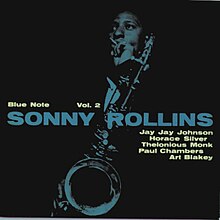
Brilliant Corners is a studio album by American jazz musician Thelonious Monk. It was his third album for Riverside Records, and the first, for this label, to include his own compositions. The complex title track required over a dozen takes in the studio.

Bags' Groove is a jazz album by Miles Davis, released in 1957 by Prestige, compiling material from two 10" LPs recorded in 1954, plus two alternative takes.

A Night at the "Village Vanguard" is a live album by American jazz saxophonist Sonny Rollins recorded at the Village Vanguard in New York City on November 3, 1957 and released on Blue Note the following year. Rollins played three sets, one in the afternoon and two in the evening, with different rhythm sections: Donald Bailey and Pete LaRoca, and Wilbur Ware and Elvin Jones, respectively.

Soul Station is an album by American jazz saxophonist Hank Mobley recorded on February 7, 1960 and released on Blue Note later that year. Mobley's quartet features rhythm section Wynton Kelly, Paul Chambers and Art Blakey.
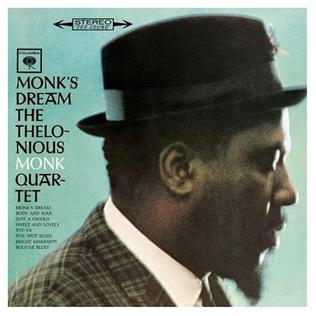
Monk's Dream is an album by jazz pianist Thelonious Monk, released by Columbia Records in March 1963. It was Monk's first album for Columbia following his five-year recording period with Riverside Records.

Inner Urge is an album by the jazz saxophonist Joe Henderson, released in 1966 via Blue Note Records, his fourth recorded as a leader. It was recorded at the Van Gelder Studio, Englewood Cliffs, New Jersey, on November 30, 1964. Featuring Henderson along with pianist McCoy Tyner and drummer Elvin Jones, and bassist Bob Cranshaw.

Blowin' the Blues Away is an album by the Horace Silver Quintet & Trio, recorded at Van Gelder Studio in Englewood Cliffs, New Jersey on August 29–30 and September 13, 1959 and released on Blue Note later that year. The quintet features horn section Blue Mitchell and Junior Cook and rhythm section Eugene Taylor and Louis Hayes.
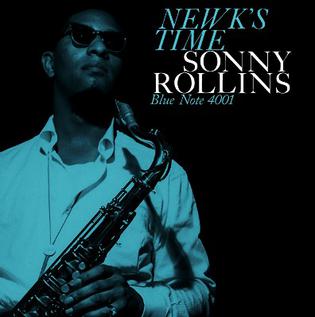
Newk's Time is an album by American jazz saxophonist Sonny Rollins recorded on September 22, 1957 and released on Blue Note in 1959—his third album for the label.

East Broadway Run Down is an album by jazz saxophonist Sonny Rollins recorded in 1966 and released in 1967 by Impulse Records, his last album before industry pressures led him to take a six-year hiatus. The album represents one of his more notable experiments with free jazz, according to The New Grove Dictionary of Jazz illustrating "the furthest extent to which he incorporated noise elements into his playing". It has been critically described as among his 60s "jewels".
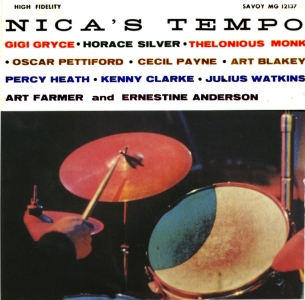
Nica's Tempo is the most common latter-day title of an album by the Gigi Gryce Orchestra and Quartet, recorded and first released in late 1955. The title track is a reference to Nica de Koenigswarter a.k.a. "The Bebop Baroness" or "The Jazz Baroness", a patron of jazz musicians such as Thelonious Monk and Charlie Parker.

The Complete Blue Note Recordings of Thelonious Monk is a box set by American jazz pianist Thelonious Monk compiling his recordings for Blue Note first released as a limited four-LP box set on Mosaic Records in 1983 before being issued as a four-CD box set by Blue Note for the first time in 1994 as The Complete Blue Note Recordings.

Milt Jackson and the Thelonious Monk Quintet is an album by American jazz vibraphonist Milt Jackson, recorded on July 2, 1948, July 23, 1951 and April 7, 1952 and released on Blue Note in 1956. The latter two sessions were originally released on ten-inch LP as Wizard of the Vibes (1952).
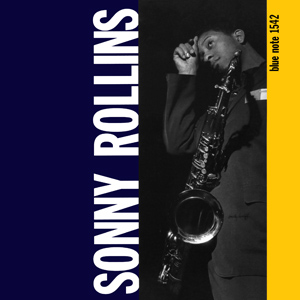
Sonny Rollins, also known as Sonny Rollins, Volume 1, is an album by American jazz saxophonist Sonny Rollins recorded on December 16, 1956 and released on Blue Note the following year.

Moving Out is an album by jazz saxophonist Sonny Rollins. This was his second for Prestige Records, featuring Kenny Dorham, Elmo Hope, Percy Heath, and Art Blakey, and one track with Thelonious Monk, Tommy Potter, and Art Taylor. The first 4 tracks had originally appeared on as the 10-inch LP Sonny Rollins Quintet Featuring Kenny Dorham, and the final track had appeared on the 10-inch LP Sonny Rollins and Thelonious Monk.

Monk is a 1956 compilation album by jazz pianist and composer Thelonious Monk, featuring material recorded from 1953 to 1954 for the Prestige label and performed by Monk with two quintets, one featuring Julius Watkins, Sonny Rollins, Percy Heath, and Willie Jones and one featuring Ray Copeland, Frank Foster, Curly Russell, and Art Blakey. It was originally titled both Thelonious Monk [on its 1956 cover] and Thelonious Monk Quintets [on its labels]. Over the following decade, it was also re-released as Wee See and The Golden Monk The most common cover art, is 1958 revision, designed by Reid Miles.
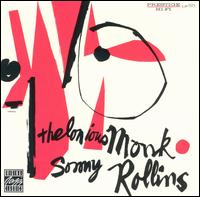
Thelonious Monk and Sonny Rollins is a compilation album by jazz pianist and composer Thelonious Monk and saxophonist Sonny Rollins released in 1956 by Prestige Records. The tracks on it were recorded in three sessions between 1953 and 1954. While this is its original title, and its most consistent title in its digital re-releases, it was also released on Prestige as Work! and The Genius Of Thelonious Monk, with alternative covers.
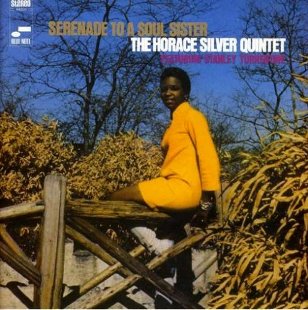
Serenade to a Soul Sister is an album by jazz pianist Horace Silver released on the Blue Note label in 1968, featuring performances by Silver with Charles Tolliver, Stanley Turrentine, Bennie Maupin, Bob Cranshaw, John Williams, Mickey Roker and Billy Cobham.
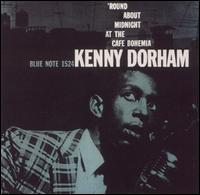
'Round About Midnight at the Cafe Bohemia is a live album by American jazz trumpeter Kenny Dorham recorded at the Café Bohemia on May 31, 1956 and released on Blue Note later that year.

J. R. Monterose is the debut album by American jazz saxophonist J. R. Monterose, recorded on October 21, 1956 and released on Blue Note the following year. The quintet features trumpeter Ira Sullivan and rhythm section Horace Silver, Wilbur Ware and Philly Joe Jones.

By the end of the 1940s, the nervous energy and tension of bebop was replaced with a tendency towards calm and smoothness, with the sounds of cool jazz, which favoured long, linear melodic lines. It emerged in New York City, as a result of the mixture of the styles of predominantly white swing jazz musicians and predominantly black bebop musicians, and it dominated jazz in the first half of the 1950s. The starting point were a series of singles on Capitol Records in 1949 and 1950 of a nonet led by trumpeter Miles Davis, collected and released first on a ten-inch and later a twelve-inch as the Birth of the Cool. Cool jazz recordings by Chet Baker, Dave Brubeck, Bill Evans, Gil Evans, Stan Getz and the Modern Jazz Quartet usually have a "lighter" sound which avoided the aggressive tempos and harmonic abstraction of bebop. Cool jazz later became strongly identified with the West Coast jazz scene, but also had a particular resonance in Europe, especially Scandinavia, with emergence of such major figures as baritone saxophonist Lars Gullin and pianist Bengt Hallberg. The theoretical underpinnings of cool jazz were set out by the blind Chicago pianist Lennie Tristano, and its influence stretches into such later developments as Bossa nova, modal jazz, and even free jazz. See also the list of cool jazz and West Coast musicians for further detail.
